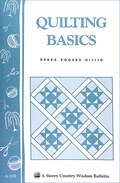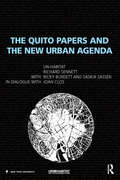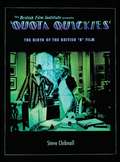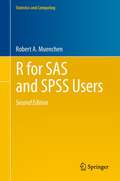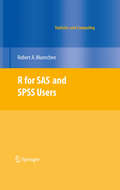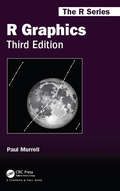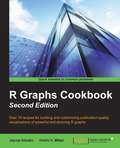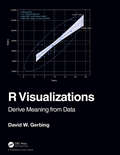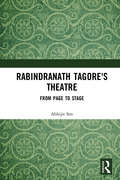- Table View
- List View
Quilting Basics: Storey's Country Wisdom Bulletin A-109 (Storey Country Wisdom Bulletin)
by Debra Rogers-GilligSince 1973, Storey's Country Wisdom Bulletins have offered practical, hands-on instructions designed to help readers master dozens of country living skills quickly and easily. There are now more than 170 titles in this series, and their remarkable popularity reflects the common desire of country and city dwellers alike to cultivate personal independence in everyday life.
Quilting For Dummies
by Cheryl FallGet the know-how you need to create beautiful quilts and decorative quilted items Quilting is a fun hobby -- but where do you begin? From selecting fabrics and designing a quilt to stitching by hand or machine, this friendly guide shows you how to put all the pieces together -- and create a wide variety of quilted keepsakes for your home. We'll have you in stitches in no time! Discover how to * Select the right fabrics and threads * Design your masterpiece * Use quilting software * Save time with rotary cutters and other cool tools * Quilt by hand or machine * Get creative with applique
Quilting For Dummies
by Cheryl FallGet the know-how you need to create beautiful quilts and decorative quilted items Quilting is a fun hobby -- but where do you begin? From selecting fabrics and designing a quilt to stitching by hand or machine, this friendly guide shows you how to put all the pieces together -- and create a wide variety of quilted keepsakes for your home. We'll have you in stitches in no time! Discover how to * Select the right fabrics and threads * Design your masterpiece * Use quilting software * Save time with rotary cutters and other cool tools * Quilt by hand or machine * Get creative with applique
Quilting with a Modern Slant: People, Patterns, and Techniques Inspiring the Modern Quilt Community
by Rachel MayModern quilting allows artists the freedom to expand on traditions and use fabrics, patterns, colors, and stitching innovatively to create exciting fresh designs. In Quilting with a Modern Slant, Rachel May introduces you to more than 70 modern quilters who have developed their own styles, methods, and aesthetics. Their ideas, quilts, tips, tutorials, and techniques will inspire you to try something new and follow your own creativity — wherever it leads.
Quilts from the Country: Patchwork projects to decorate your home
by null Stuart HillardA seasonal collection of quilts inspired by life in the countryside. With twenty new projects that are suitable for a range of skill levels and include: 12 large quilts and 8 smaller items, which can be customised to suit your own décor. A brand new collection of quilts and projects from one of the most recognisable and best-loved quilt designers in the UK. These inspiring designs, photographed in beautiful rural locations, reflect the changing seasons and beauty of the British countryside. Each of the four chapters features inspirational lifestyle photography showing the quilts in beautifully styled settings. For all skill levels from beginner to advanced, the book includes the guidance and practical knowledge you need to begin quilting successfully. The 12 large quilts and 8 smaller projects and accessories can also be made in alternative colours and fabrics to fit your own style, making them enormously versatile. This is the book for any quilter and lover of country style.
Quintessential Tarantino: The Films Of Quentin Tarantino
by Edwin PageFrom Reservoir Dogs in 1992 to the Kill Bill series of films, the films of Quentin Tarantino have always provoked a reaction from critics and audiences alike - many attracting a cult-like following. Edwin Page discusses each of the eight films written and directed by Tarantino, and explores the complexity behind Tarantino's 'guns and gangsters' style. Films discuseed include Reservoir Dogs, True Romance, Natural Born Killers, Pulp Fiction, From Dusk Till Dawn, Jackie Brown, and Kill Bill Volumes 1 and 2. A book for film students and media studies, in which the reader can discover how Tarantino went from video store clerk to director of major movies.
The Quintessential Zerka: Writings by Zerka Toeman Moreno on Psychodrama, Sociometry and Group Psychotherapy
by Zerka T MorenoThe Quintessential Zerka documents the origins and development of the theory and practice of psychodrama, sociometry and group psychotherapy through the work and innovation of its co-creator, Zerka Toeman Moreno. This comprehensive handbook brings together history, philosophy, methodology and application. It shows the pioneering role that Zerka, along with her husband J. L. Moreno, played in the development, not only of the methods of psychodrama and sociometry, but of the entire group psychotherapy movement worldwide. It demonstrates the extent to which Zerka's intuitive and intellectual grasp of the work, combined with her superb ability to organize and synthesize, continue to exert an influence on the field. Toni Horvatin and Edward Schreiber have selected articles that span a career of some sixty years, from Zerka’s very first publication to recent, previously unpublished, work. Personal anecdotes and poetry from Zerka herself provide a valuable context for each individual article. The selection includes: psychodrama, it's relation to stage, radio and motion pictures psychodramatic rules, techniques and adjunctive methods beyond aristotle, breuer and freud: Moreno’s contribution to the concept of catharsis psychodrama, role theory and the concept of the social atom. This book provides a rich source of insight and inspiration for all those interested in the history, development and practice of psychodrama, sociometry and group psychotherapy, whatever their level of experience. It will be of interest to anyone involved in the fields of psychology, counselling, sociology, social work, education, theatre, or human relations.
The Quintessential Zerka: Writings by Zerka Toeman Moreno on Psychodrama, Sociometry and Group Psychotherapy
by Zerka T MorenoThe Quintessential Zerka documents the origins and development of the theory and practice of psychodrama, sociometry and group psychotherapy through the work and innovation of its co-creator, Zerka Toeman Moreno. This comprehensive handbook brings together history, philosophy, methodology and application. It shows the pioneering role that Zerka, along with her husband J. L. Moreno, played in the development, not only of the methods of psychodrama and sociometry, but of the entire group psychotherapy movement worldwide. It demonstrates the extent to which Zerka's intuitive and intellectual grasp of the work, combined with her superb ability to organize and synthesize, continue to exert an influence on the field. Toni Horvatin and Edward Schreiber have selected articles that span a career of some sixty years, from Zerka’s very first publication to recent, previously unpublished, work. Personal anecdotes and poetry from Zerka herself provide a valuable context for each individual article. The selection includes: psychodrama, it's relation to stage, radio and motion pictures psychodramatic rules, techniques and adjunctive methods beyond aristotle, breuer and freud: Moreno’s contribution to the concept of catharsis psychodrama, role theory and the concept of the social atom. This book provides a rich source of insight and inspiration for all those interested in the history, development and practice of psychodrama, sociometry and group psychotherapy, whatever their level of experience. It will be of interest to anyone involved in the fields of psychology, counselling, sociology, social work, education, theatre, or human relations.
The Quite Nice and Fairly Accurate Good Omens Script Book
by Neil GaimanThe Quite Nice and Fairly Accurate Good Omens Script Book contains much that is new and revelatory and even several scenes that are not actually in the final television series.'One of the most hotly anticipated TV shows of the year' Independent'Even if you're very familiar with the original novel, this is a different experience... so damned charming and quirky that it feels like a must' StarburstNeil Gaiman's glorious reinvention of the iconic bestseller Good Omens is adapted from the internationally beloved novel by Terry Pratchett and Neil Gaiman and is soon to be a massive new TV launch on Amazon Prime Video and the BBC. The series is written and show-run by Neil himself and stars David Tennant, Michael Sheen, Jon Hamm and Miranda Richardson, to name but a few.**Includes an introduction by Neil Gaiman about bringing Good Omens to the screen**Before he died in 2015, Terry Pratchett asked Neil Gaiman to make a television series of the internationally beloved novel they wrote together about the end of the world. And so, Neil began to write. And continued to write until he had six episodes that brought an angel, Aziraphale, and a demon, Crowley, (the only things standing between us and the inevitable Armageddon) to life for the screen. Contained between the covers of this book are the scripts that Neil wrote, which later turned into some of the most extraordinary television ever made. Take a tour behind the scenes with a text that reveals the secrets of the show, still has the missing bits and, sometimes, asks for the impossible. Step backstage and see the magic for yourself. You may just learn as much from the scenes that never made the final cut as from those that did.
The Quito Papers and the New Urban Agenda
by Un-HabitatThe future is urban. Indeed, the battle for sustainable development will be won or lost in cities. Not a moment too soon, then, that urbanization is suddenly at the centre of global policy making. In 2015 the governments of the UN adopted the 2030 Agenda for Sustainable Development and in 2016 they adopted the New Urban Agenda. However, the question of how these Agendas will be pursued concretely remains. Unfortunately, the prevailing model is rigidly technocratic Charter of Athens from 1933—the strict functionalist separation of activities that it prescribes still dominates planning practices worldwide. The purpose of The Quito Papers and the New Urban Agenda is to start a discussion that both challenges this status quo and opens up new lines of enquiry. It intentionally does not propose a manifesto made up of simplistic slogans and recommendations as cities in the 21st century are more fragile and complex. Its content, therefore, is intentionally broad, ranging from architecture, planning and urban design, to land ownership and regulation, water management and environmental philosophy. This multifaceted assembly of perspectives critiques the tenets of the Charter of Athens, identify new trends and propose new insights on contemporary urbanization. Part One outlines the overall challenges facing cities in the 21st century and Part Two offers a number of conceptual frameworks and approaches for dealing with those challenges. Each Part is also composed of a body of illustrated arguments, synthesized from selectively-abridged background papers from over 15 commissioned authors, interspersed with in-depth papers.
The Quito Papers and the New Urban Agenda
by Un-HabitatThe future is urban. Indeed, the battle for sustainable development will be won or lost in cities. Not a moment too soon, then, that urbanization is suddenly at the centre of global policy making. In 2015 the governments of the UN adopted the 2030 Agenda for Sustainable Development and in 2016 they adopted the New Urban Agenda. However, the question of how these Agendas will be pursued concretely remains. Unfortunately, the prevailing model is rigidly technocratic Charter of Athens from 1933—the strict functionalist separation of activities that it prescribes still dominates planning practices worldwide. The purpose of The Quito Papers and the New Urban Agenda is to start a discussion that both challenges this status quo and opens up new lines of enquiry. It intentionally does not propose a manifesto made up of simplistic slogans and recommendations as cities in the 21st century are more fragile and complex. Its content, therefore, is intentionally broad, ranging from architecture, planning and urban design, to land ownership and regulation, water management and environmental philosophy. This multifaceted assembly of perspectives critiques the tenets of the Charter of Athens, identify new trends and propose new insights on contemporary urbanization. Part One outlines the overall challenges facing cities in the 21st century and Part Two offers a number of conceptual frameworks and approaches for dealing with those challenges. Each Part is also composed of a body of illustrated arguments, synthesized from selectively-abridged background papers from over 15 commissioned authors, interspersed with in-depth papers.
Quiz (Modern Plays)
by James GrahamI have to believe in the institutions we trust to be fair, and functional. Whether that be the judiciary, the police, the media … That they should all be able to resist the temptations of a more entertaining lie, over a less extraordinary truth.April 2003. Army Major Charles Ingram, his wife and coughing accomplice are convicted for cheating on Who Wants to Be a Millionaire?The evidence is damning. The nation is gripped by the sheer audacity of the plot to snatch the £1,000,000 jackpot. But was he really guilty? It's time for you to decide.Question everything you think you know in James Graham's provocative new play.Olivier Award-nominee James Graham returns with a sharp, fictional imagination of one of the most famous quiz show controversies to date. The production premiered at Chichester Festival Theatre and this edition was published this edition was published to coincide with the West End opening at the Nöel Coward Theatre in April 2018.
Quiz (Modern Plays)
by James GrahamI have to believe in the institutions we trust to be fair, and functional. Whether that be the judiciary, the police, the media … That they should all be able to resist the temptations of a more entertaining lie, over a less extraordinary truth.April 2003. Army Major Charles Ingram, his wife and coughing accomplice are convicted for cheating on Who Wants to Be a Millionaire?The evidence is damning. The nation is gripped by the sheer audacity of the plot to snatch the £1,000,000 jackpot. But was he really guilty? It's time for you to decide.Question everything you think you know in James Graham's provocative new play.Olivier Award-nominee James Graham returns with a sharp, fictional imagination of one of the most famous quiz show controversies to date. The production premiered at Chichester Festival Theatre and this edition was published this edition was published to coincide with the West End opening at the Nöel Coward Theatre in April 2018.
Quota Quickies: The Birth Of The British 'b' Film
by Steve ChibnallThis book, the first of two volumes, will provide a major new history of the British B film, tracing the development of the low-budget supporting feature from the 1927 Films Act (which introduced a quota system for the distribution and exhibition of indigenous product) to the age of television, when B film producers channelled their energies into making TV programmes. Along the way, the authors will address leading producers and studios, B film stars, distributors, the genres and themes that tended to dominate B film production (comedy, horror, crime and fantasy). 'Quota Quickies' will include a case study of the B films of Michael Powell. The authors' argument is that the B film was hugely important in British cinema history in offering an opportunity for British actors and technicians to develop their careers, and that the films themselves provided an outlet for the exploration of peculiarly British cultural concerns in an industry traditionally dominated by Hollywood output. They also contend that some of the films stand up well to contemporary viewing and are deserving of critical re-evaluation.
Quota Quickies
by Steve ChibnallThis book, the first of two volumes, will provide a major new history of the British B film, tracing the development of the low-budget supporting feature from the 1927 Films Act (which introduced a quota system for the distribution and exhibition of indigenous product) to the age of television, when B film producers channelled their energies into making TV programmes. Along the way, the authors will address leading producers and studios, B film stars, distributors, the genres and themes that tended to dominate B film production (comedy, horror, crime and fantasy). 'Quota Quickies' will include a case study of the B films of Michael Powell. The authors' argument is that the B film was hugely important in British cinema history in offering an opportunity for British actors and technicians to develop their careers, and that the films themselves provided an outlet for the exploration of peculiarly British cultural concerns in an industry traditionally dominated by Hollywood output. They also contend that some of the films stand up well to contemporary viewing and are deserving of critical re-evaluation.
Quotenkiller oder Qualitätsfernsehen?: TV-Serien aus französisch- und spanischsprachigen Kulturräumen (Serienräume – global, lokal, glokal)
by Julien Bobineau Jörg TürschmannDer bisherige Fokus der TV-Serienforschung auf US-amerikanische Produktionen hat gemeinsam mit dem steten Aufstieg innovativer Serienformate aus der Romania zu einer großen Forschungslücke geführt. Der Sammelband versucht diese Leerstellen durch ausgewählte Überblicksbeiträge und Fallstudien zu schließen und zu weiterführenden Forschungen innerhalb der Literatur-, Kultur-, Medien- und Filmwissenschaften anzuregen.
R for SAS and SPSS Users (Statistics and Computing)
by Robert A. MuenchenR is a powerful and free software system for data analysis and graphics, with over 5,000 add-on packages available. This book introduces R using SAS and SPSS terms with which you are already familiar. It demonstrates which of the add-on packages are most like SAS and SPSS and compares them to R's built-in functions. It steps through over 30 programs written in all three packages, comparing and contrasting the packages' differing approaches. The programs and practice datasets are available for download.The glossary defines over 50 R terms using SAS/SPSS jargon and again using R jargon. The table of contents and the index allow you to find equivalent R functions by looking up both SAS statements and SPSS commands. When finished, you will be able to import data, manage and transform it, create publication quality graphics, and perform basic statistical analyses. This new edition has updated programming, an expanded index, and even more statistical methods covered in over 25 new sections.
R for SAS and SPSS Users (Statistics and Computing #Vol. 9)
by Robert A. MuenchenWhile SAS and SPSS have many things in common, R is very different. My goal in writing this book is to help you translate what you know about SAS or SPSS into a working knowledge of R as quickly and easily as possible. I point out how they differ using terminology with which you are familiar, and show you which add-on packages will provide results most like those from SAS or SPSS. I provide many example programs done in SAS, SPSS, and R so that you can see how they compare topic by topic. When finished, you should be able to use R to: Read data from various types of text files and SAS/SPSS datasets. Manage your data through transformations or recodes, as well as splitting, merging and restructuring data sets. Create publication quality graphs including bar, histogram, pie, line, scatter, regression, box, error bar, and interaction plots. Perform the basic types of analyses to measure strength of association and group differences, and be able to know where to turn to cover much more complex methods.
R Graphics, Third Edition (Chapman & Hall/CRC The R Series)
by Paul MurrellThis third edition of Paul Murrell’s classic book on using R for graphics represents a major update, with a complete overhaul in focus and scope. It focuses primarily on the two core graphics packages in R - graphics and grid - and has a new section on integrating graphics. This section includes three new chapters: importing external images in to R; integrating the graphics and grid systems; and advanced SVG graphics.The emphasis in this third edition is on having the ability to produce detailed and customised graphics in a wide variety of formats, on being able to share and reuse those graphics, and on being able to integrate graphics from multiple systems.This book is aimed at all levels of R users. For people who are new to R, this book provides an overview of the graphics facilities, which is useful for understanding what to expect from R's graphics functions and how to modify or add to the output they produce. For intermediate-level R users, this book provides all of the information necessary to perform sophisticated customizations of plots produced in R. For advanced R users, this book contains vital information for producing coherent, reusable, and extensible graphics functions.
R Graphics, Third Edition (Chapman & Hall/CRC The R Series)
by Paul MurrellThis third edition of Paul Murrell’s classic book on using R for graphics represents a major update, with a complete overhaul in focus and scope. It focuses primarily on the two core graphics packages in R - graphics and grid - and has a new section on integrating graphics. This section includes three new chapters: importing external images in to R; integrating the graphics and grid systems; and advanced SVG graphics.The emphasis in this third edition is on having the ability to produce detailed and customised graphics in a wide variety of formats, on being able to share and reuse those graphics, and on being able to integrate graphics from multiple systems.This book is aimed at all levels of R users. For people who are new to R, this book provides an overview of the graphics facilities, which is useful for understanding what to expect from R's graphics functions and how to modify or add to the output they produce. For intermediate-level R users, this book provides all of the information necessary to perform sophisticated customizations of plots produced in R. For advanced R users, this book contains vital information for producing coherent, reusable, and extensible graphics functions.
R Graphs Cookbook Second Edition
by Jaynal Abedin Hrishi V. MittalTargeted at those with an existing familiarity with R programming, this practical guide will appeal directly to programmers interested in learning effective data visualization techniques with R and a wide-range of its associated libraries.
R Visualizations: Derive Meaning from Data
by David GerbingR Visualizations: Derive Meaning from Data focuses on one of the two major topics of data analytics: data visualization, a.k.a., computer graphics. In the book, major R systems for visualization are discussed, organized by topic and not by system. Anyone doing data analysis will be shown how to use R to generate any of the basic visualizations with the R visualization systems. Further, this book introduces the author’s lessR system, which always can accomplish a visualization with less coding than the use of other systems, sometimes dramatically so, and also provides accompanying statistical analyses. Key Features Presents thorough coverage of the leading R visualization system, ggplot2. Gives specific guidance on using base R graphics to attain visualizations of the same quality as those provided by ggplot2. Shows how to create a wide range of data visualizations: distributions of categorical and continuous variables, many types of scatterplots including with a third variable, time series, and maps. Inclusion of the various approaches to R graphics organized by topic instead of by system. Presents the recent work on interactive visualization in R. David W. Gerbing received his PhD from Michigan State University in 1979 in quantitative analysis, and currently is a professor of quantitative analysis in the School of Business at Portland State University. He has published extensively in the social and behavioral sciences with a focus on quantitative methods. His lessR package has been in development since 2009.
R Visualizations: Derive Meaning from Data
by David GerbingR Visualizations: Derive Meaning from Data focuses on one of the two major topics of data analytics: data visualization, a.k.a., computer graphics. In the book, major R systems for visualization are discussed, organized by topic and not by system. Anyone doing data analysis will be shown how to use R to generate any of the basic visualizations with the R visualization systems. Further, this book introduces the author’s lessR system, which always can accomplish a visualization with less coding than the use of other systems, sometimes dramatically so, and also provides accompanying statistical analyses. Key Features Presents thorough coverage of the leading R visualization system, ggplot2. Gives specific guidance on using base R graphics to attain visualizations of the same quality as those provided by ggplot2. Shows how to create a wide range of data visualizations: distributions of categorical and continuous variables, many types of scatterplots including with a third variable, time series, and maps. Inclusion of the various approaches to R graphics organized by topic instead of by system. Presents the recent work on interactive visualization in R. David W. Gerbing received his PhD from Michigan State University in 1979 in quantitative analysis, and currently is a professor of quantitative analysis in the School of Business at Portland State University. He has published extensively in the social and behavioral sciences with a focus on quantitative methods. His lessR package has been in development since 2009.
Rabindranath Tagore's Theatre: From Page to Stage
by Abhijit SenThis book analyses Rabindranath Tagore’s contribution to Bengali drama and theatre. Throughout this book, Abhijit Sen locates and studies Rabindranath’s experiments with drama/theatre in the context of the theatre available in nineteenth-century Bengal, and explores the innovative strategies he adopted to promote his ‘brand’ of theatre. This approach finds validation in the fact that Rabindranath combined in himself the roles of author-actor-producer, who always felt that, without performance, his dramatic compositions fell short of the desired completeness. Various facets of his plays as theatre and his own role as a theatre-practitioner are the prime focus of this book. This book will be of great interest to students and scholars in Theatre and Performance Studies and most notably, those focusing on Indian Theatre and Postcolonial Theatre.
Rabindranath Tagore's Theatre: From Page to Stage
by Abhijit SenThis book analyses Rabindranath Tagore’s contribution to Bengali drama and theatre. Throughout this book, Abhijit Sen locates and studies Rabindranath’s experiments with drama/theatre in the context of the theatre available in nineteenth-century Bengal, and explores the innovative strategies he adopted to promote his ‘brand’ of theatre. This approach finds validation in the fact that Rabindranath combined in himself the roles of author-actor-producer, who always felt that, without performance, his dramatic compositions fell short of the desired completeness. Various facets of his plays as theatre and his own role as a theatre-practitioner are the prime focus of this book. This book will be of great interest to students and scholars in Theatre and Performance Studies and most notably, those focusing on Indian Theatre and Postcolonial Theatre.
